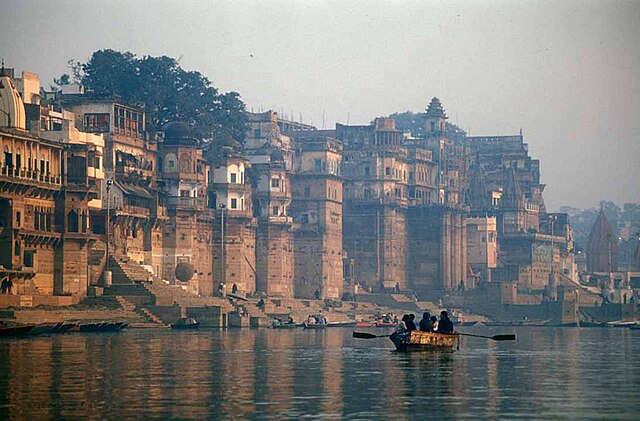Bhojpur is a ethnolinguistic and cultural area in the Indian subcontinent where the Bhojpuri language is spoken as a mother tongue. The Bhojpuri region encompasses parts of the Indian states of Bihar, Uttar Pradesh, and Jharkhand, and the Madhesh, Gandaki and Lumbini provinces of Nepal.[1][2][3][4]
This article has multiple issues. Please help improve it or discuss these issues on the talk page. (Learn how and when to remove these messages)
|
History
Pre-history and Antiquity
The earliest known evidence of Human settlement in the region are the Cave painting of Kaimur and Mirzapur.[5][6][7] The first Neolithic settlement found in this region is in Chirand of Saran, which dates back 2500-1500 B.C. and is contemporary to the Harrapans.[8] Historically, the region was part of Malla and Kashi Mahajanapadas.[9] Varanasi, known as the center of the Bhojpuri cultural region is one of the world's oldest continuously inhabited cities.[10][11]
Etymology
The Bhojpuri region received its name after the town of Bhojpur (Arrah), the headquarters of the Ujjainiya Rajputs of the former Shahabad district of Bihar.[12]
Culture
The economic and industrial growth of this region had been greatly hindered because of caste-guided political in-fighting and a huge population.[13]
The culture of Bhojpur is also very much present today in Trinidad and Tobago, Jamaica, Guyana, Suriname, Fiji, Mauritius, and South Africa, due to the many Indian indentured laborers who were sent there by the ruling British in the mid 19th century to the early 20th century, and were from the Purvanchal-Bhojpur region.

Language

Bhojpuri language is a descendant of Magadhi Prakrit which started taking in shape during the reign of the Vardhana dynasty.[14][15] The earliest form of Bhojpuri can be traced in the Siddha Sahitya and Charyapada as early as 7th century A.D.[16][17][18] It is an eastern Indo-Aryan language and one of the easternmost branches of the Indo-European language family.[19] The Bhojpuri variant of Kaithi is the indigenous script of Bhojpuri language.[20][21][22]
Festivals
Chhath Puja and Durga Puja are the biggest festivals of Bhojpuri region.[23][24][25][26][27]
Other important festivals include Phagwah, Saraswati Puja, Deepavali, Dussehra, Vishwakarma Puja, Ramnavami, Teej, Jitiya, Janmashtami, Anant Chaturdashi, Dev Deepawali, Pidiya, Bahura, Godhan, Chauk Chanda, Raksha Bandhan, Nag Nathaiya, Naga Panchami, Karma, etc.[28][29][30]
Music
Bhojpuri music is a form of Hindustani Classical Music and includes a broad array of Bhojpuri language performances in distinct style, both traditional and modern.
Art
Bhojpuri painting is a folk painting style that has flourished in the Bhojpuri region thousands of years ago. This painting style is a type of wall painting primarily done on temple walls or on walls of the rooms of newly married couples and the main motifs are that of Lord Shiva and Goddess Parvati. Although in recent times motifs of natural objects and life and struggles of village people are also depicted to make the painting more acceptable among the common people and bring the style close to reality.[31]
Textile arts

Silk weaving is a manufacturing industry in Varanasi. Varanasi is known throughout India for its production of very fine silk and Banarasi saris and salwar suits.
Cuisine
Bhojpuri cuisine (Bhojpuri: 𑂦𑂷𑂔𑂣𑂳𑂩𑂲𑂨𑂰 𑂦𑂷𑂔) is a style of food preparation common among the Bhojpuri people. Bhojpuri foods are mostly mild and tend to be less hot in terms of spices used. The cuisine consists of both vegetable and meat dishes.[32]
Districts

Bhojpuri language is spoken in the districts of Western Bihar and Eastern Uttar Pradesh which is called Purvanchal.[33]
Patna division: Bhojpur district, Buxar district, Kaimur district and Rohtas district.
Saran division: Saran district, Siwan district, Gopalganj district.
Tirhut division: West Champaran district, East Champaran district.
Varanasi division: Chandauli district, Ghazipur district, Jaunpur district, Varanasi district.
Gorakhpur division: Deoria district, Gorakhpur district, Kushinagar district, Maharajganj district.

Azamgarh division: Azamgarh district, Ballia district, Mau district.
Mirzapur division: Mirzapur district, Sant Ravidas Nagar district, Sonbhadra district.
Basti division: Sant Kabir Nagar district, Siddharthnagar district, Basti district
Palamu division: Palamu district, Garhwa district
Madhesh Province (Nepal)
Bara district, Parsa district, Rautahat district
Lumbini Province (Nepal)
Parasi district, Rupandehi district
Note that Bhojpur district of Koshi Pradesh is not an Indo-Aryan Bhojpuri ethnolinguistic region, although it shares the same name.
Religion
According to the 2011 Census, Hindus form the majority in the Bhojpuri region, with 85.33% adhering to Hinduism. Islam is practiced by 14.5% of the population, while 0.52% profess other religions.
See also
References
Wikiwand in your browser!
Seamless Wikipedia browsing. On steroids.
Every time you click a link to Wikipedia, Wiktionary or Wikiquote in your browser's search results, it will show the modern Wikiwand interface.
Wikiwand extension is a five stars, simple, with minimum permission required to keep your browsing private, safe and transparent.

